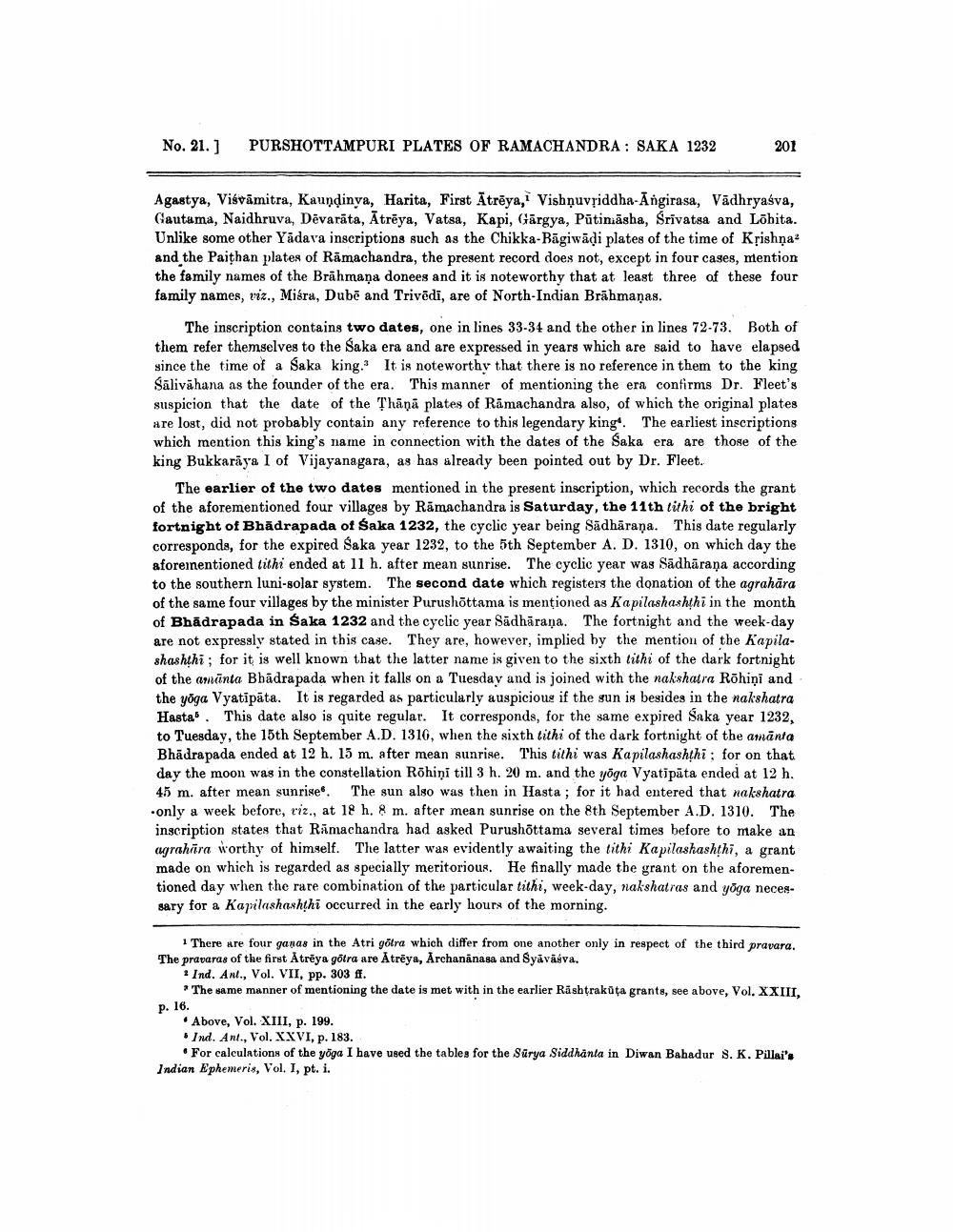________________
No. 21.1
PURSHOTTAMPURI PLATES OF RAMACHANDRA: SAKA 1232
201
Agastya, Visvāmitra, Kauņdinya, Harita, First Atrēya, Vishộuvșiddha-Angirasa, Vādhryaśva, Gautama, Naidhruva, Dēvarāta, Ātrēya, Vatsa, Kapi, Gārgya, Pūtināsha, Srivatsa and Lõbita. Unlike some other Yadava inscriptions such as the Chikka-Bāgiwādi plates of the time of Krishna and the Paithan plates of Ramachandra, the present record does not, except in four cases, mention the family names of the Brāhmaṇa donees and it is noteworthy that at least three of these four family names, viz., Miśra, Dubē and Trivēdi, are of North-Indian Brāhmaṇas.
The inscription contains two dates, one in lines 33-34 and the other in lines 72-73. Both of them refer themselves to the Saka era and are expressed in years which are said to have elapsed since the time of a Saka king. It is noteworthy that there is no reference in them to the king Sālivähana as the founder of the era. This manner of mentioning the era confirms Dr. Fleet's suspicion that the date of the Thāņā plates of Ramachandra also, of which the original plates are lost, did not probably contain any reference to this legendary king. The earliest inscriptions which mention this king's name in connection with the dates of the Saka era are those of the king Bukkarāya I of Vijayanagara, as has already been pointed out by Dr. Fleet.
The earlier of the two dates mentioned in the present inscription, which records the grant of the aforementioned four villages by Ramachandra is Saturday, the 11th tithi of the bright fortnight of Bhadrapada of Saka 1232, the cyclic year being Sädhärana. This date regularly corresponds, for the expired Saka year 1232, to the 5th September A. D. 1310, on which day the aforeinentioned tithi ended at 11 h. after mean sunrise. The cyclic year was Sadhāraņa according to the southern luni-solar system. The second date which registers the donation of the agrahāra of the same four villages by the minister Purushottama is mentioned as Kapilashashthi in the month of Bhādrapada in Saka 1232 and the cyclic year Sadhāraņa. The fortnight and the week-day are not expressly stated in this case. They are, however, implied by the mention of the Kapilashashthi ; for it is well known that the latter name is given to the sixth tithi of the dark fortnight of the amānta Bbādrapada when it falls on a Tuesday and is joined with the nakshatra Rõhiņi and the yoga Vyatipāta. It is regarded as particularly auspicious if the sun is besides in the nakshatra Hasta. This date also is quite regular. It corresponds, for the same expired Saka year 1232, to Tuesday, the 15th September A.D. 1310, when the sixth tithi of the dark fortnight of the amanta Bhādrapada ended at 12 h. 15 m. after mean sunrise. This tithi was Kapilashashthi: for on that day the moon was in the constellation Rõhiņi till 3 h. 20 m. and the yoga Vyatipāta ended at 12 h. 45 m. after mean sunrise. The sun also was then in Hasta ; for it had entered that nakshatra only a week before, viz., at 18 h. 8 m. after mean sunrise on the 8th September A.D. 1310. The inscription states that Ramachandra had asked Purushottama several times before to make an agrahāra worthy of himself. The latter was evidently awaiting the tithi Kapilashashthi, a grant made on which is regarded as specially meritorious. He finally made the grant on the aforementioned day when the rare combination of the particular tithi, week-day, nakshatras and yoga necessary for a Kapilashashthi occurred in the early hours of the morning.
1 There are four gawas in the Atri götra which differ from one another only in respect of the third pravara. The pravaras of the first Atrēya götra are Atrēya, Archananasa and Syāvā va.
Ind. Ant., Vol. VII, pp. 303 ff. * The same manner of mentioning the date is met with in the earlier Rashtrakta grants, see above, Vol. XXIII,
p. 16.
. Above, Vol. XIII, p. 199. • Ind. Ant., Vol. XXVI, p. 183.
• For calculations of the yoga I have used the tables for the Sürya Siddhanta in Diwan Bahadur S. K. Pillai's Indian Ephemeris, Vol. I, pt. i.




